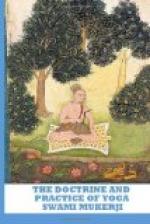Then again while bathing if you let the water flow over your body and try to “appreciate the sensation” and dwell on the idea of Prana-absorption from water, you shall get double benefit.
About linen—Be neat, for God’s sake. I have seen orthodox people who bathe twice and wash their hands hundreds of times in the day, but whose clothes are sticky with dirt, sweat and oil. Whatever else it may mean, Religion does not mean squalor, offensive odours in body and clothes and general neglect of external clean linen and dirt. The Yogi is a man of supreme REFINEMENT. Read that word and understand all it means. The clothes you wear in day-time should not be worn at night. Be clean internally as well externally. Be clean. Be clean. Be clean, within as well as without.
DRINKING WATER AND SWALLOWING AIR.
Your body needs a reasonable supply of water and air. Water is used by nature in different ways. Form the habit of drinking pure water from 5 to 8 tumblers a day. Drink slowly and form a mental image of Prana-absorption from the water.
The student needs fresh air too in plenty. If your heart and lungs are in sound condition they will draw in air naturally and extract oxygen in proper quantities. If not, perform the following exercises carefully one by one in the open air every day. They are quite reliable.
THE YOGI CLEANSING BREATH.
(1) Inhale a complete breath. (2) Retain the air a few seconds. (3) Pucker up the lips as if for a whistle (but do not swell out the cheeks) then exhale a little air through the opening with considerable vigor. Then stop for a moment retaining the air and then exhale a little more air. Repeat until the air is completely exhaled. Remember that considerable vigor is to be used in exhaling air through the opening in the lips. This breath will be found quite refreshing when one is tired and generally “used up.” A trial will convince the student of its merits. This exercise should be practised until it can be performed naturally and easily, as it is used to finish up a number of other exercises given in this book and it should be thoroughly understood.
NERVE VITALISING BREATH.
(1) Stand erect. (2) Inhale a complete breath and retain same. (3) Extend the arms straight in front of you, letting them somewhat limp and relaxed, with only sufficient nerve force to hold them out. (4) Slowly draw the hands back towards the shoulders gradually, contracting the muscles and putting force into them, so that when they reach the shoulders the fists will be so tightly clenched that a tremulous motion is felt. (5) Then keeping the muscles tense push the fists slowly out and then draw them back rapidly (still tense) several times. (6) Exhale vigorously through the mouth. (7) Practise the cleansing breath. (8) The efficiency of this exercise depends greatly upon the speed of the drawing back of the fists, and the tension of the muscles, and, of course upon the full lungs. This exercise must be tried to be appreciated. It is without equal as a “bracer” as our western friends put it.




